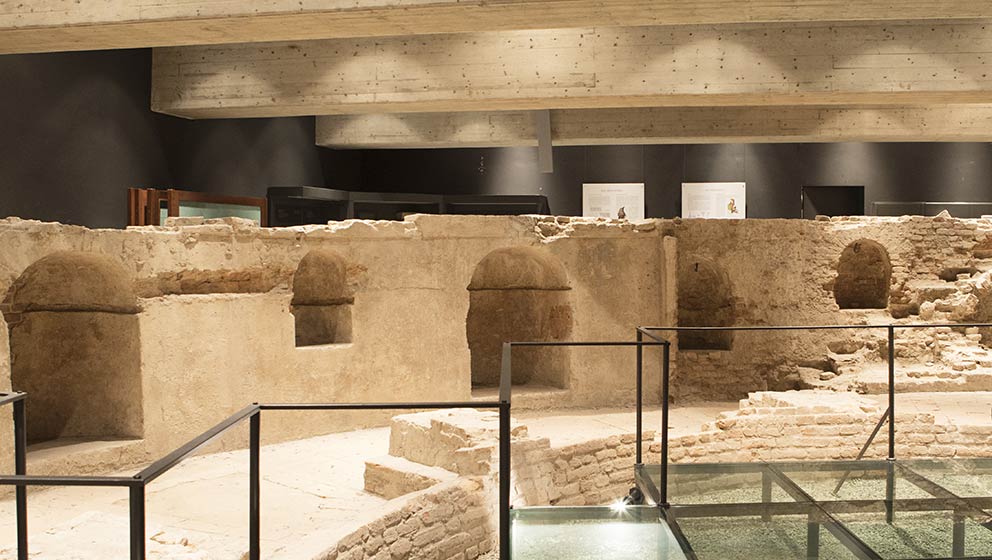
Nell’aula Bontadini, sulla parete di fondo al lato della ghiacciaia, dieci vetrine accolgono reperti archeologici provenienti dalle indagini effettuate nei cortili dell’Ateneo tra il 1986 e il 2004.
L’esposizione “L’abitato, la necropoli, il monastero” è il frutto di un lungo lavoro di ricerca cui hanno partecipato docenti e ricercatori del Dipartimento di Storia, Archeologia e Storia dell’arte, studenti e specializzandi dei corsi archeologici, attivamente coinvolti nelle varie fasi del lavoro.
La mostra è stata realizzata in collaborazione con la Soprintendenza per i Beni archeologici della Lombardia ed è la prima tappa di un percorso destinato a illustrare in modo sempre più completo il ricco deposito stratigrafico individuato durante gli scavi. Attraverso una selezione di oggetti sono illustrate le vicende delle prime fasi di occupazione, in particolare quelle del primo insediamento (fine I sec. a.C. - II sec. d.C.) e soprattutto quelle della grande necropoli che si sviluppò nell’area tra III e V secolo d.C., fino al suo abbandono.
Anfore, ceramiche d’uso comune, vasellame da mensa, lucerne, vetri, monete, sono solo alcuni dei materiali legati alle produzioni e ai commerci di età romana che, unitamente a piccoli lacerti di affreschi e a elementi marmorei di decorazione, ci aiutano a comprendere la vita quotidiana di un quartiere suburbano.
La necropoli è invece testimoniata da materiali di corredo: contenitori vitrei e ceramici con offerte, oggetti di abbigliamento, bracciali, fibule, monete, sono riflessi di credenze o pietosi e commossi gesti di commiato di quella popolazione cosmopolita che abitava la città quando Milano era una capitale imperiale.
Tra le molte tombe si distingue quella in sarcofago, ritrovato ancora sigillato, di una donna di circa 30 anni, deposta abbigliata e accompagnata con alcuni oggetti personali tra cui una rocca e un ventaglio in avorio.
Limitate ma non meno importanti le testimonianze che documentano l’abbandono della necropoli e la graduale trasformazione in orti e giardini legati al monastero ambrosiano (ceramiche e pietre ollari di V-VI, monete di X secolo).
Exhibition “the Town, the Necropolis, the Monastery”
On the back wall of the Bontadini Room, on the side of the Ice-House, ten showcases display the archaeological findings of a number of surveys carried out, between 1986 and 2004, in the courtyards of the University. The exhibition “The Town, the Necropolis, the Monastery” is the result of a long research carried out by professors and researchers from the History, Archaeology and Art History Department, by archaeological BA and PhD students, actively involved in the various stages of the work. The exhibition was organized in collaboration with Lombardy Superintendence for Archaeological Heritage and it is the first step in a process aiming to present more and more comprehensively the rich stratigraphic deposit found during the excavations.
A selection of objects recounts the events of the early stages of occupation of the site, in particular those of the first settlement (late 1st century BC – 2nd century AD) and especially those of the large necropolis that developed in this area between 3rd and 5th centuries AD until it was abandoned. Amphorae, everyday pottery, tableware, oil-lamps, glass fragments, coins. These are just some of the materials related to Roman production and commerce that, combined with small fragments of frescoes and marble decorative elements, help us understand the daily life of a suburban neighbourhood.
The presence of a necropolis, on the other hand, is attested by grave goods. Glass vessels and pottery with offerings, clothing, bracelets, fibulae and coins are reflections of beliefs or compassionate and moving gestures of farewell by the cosmopolitan population, who lived in the city when Milan was an imperial Capital.
Among the many tombs stands out a sarcophagus, that was discovered still sealed. It contained the remains of a woman of about 30 years old, clothed and placed together with some personal items, including a miniature castle and a fan in ivory. Documentation of the abandonment of the Necropolis and of its gradual transformation into orchards and gardens, linked to the Ambrosian Monastery, is limited, but not less important: 5th and 6th centuries pottery and soapstones and 10th century coins).

